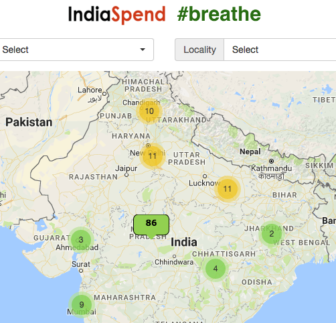Investigative reporters are constantly finding creative ways to get data, and that now includes adapting sensor technology to collect information.
Govindraj Ethiraj, founder and managing trustee of IndiaSpend, the country’s first nonprofit data journalism center, spoke at the Uncovering Asia 2016 conference Friday about his award-winning #breathe network, which is using low-cost sensors to collect air quality data in 13 cities around India. The devices are run by mobile phones to avoid wifi-related interruptions, and register information approximately every 5 minutes.

Screen shot of IndiaSpend’ #breathe project
“It’s a new world,” said Ethiraj, referring to the opportunities created by sensor journalism to make repositories of publicly accessible data, which were once only available from official sources and on a limited basis.
The project began in New Delhi, when Ethiraj read an article about air pollution levels in his city being worse than in Beijing, a city long-believed to have the worst air quality globally. The data for that story came from a single air quality sensor on the roof of the U.S. Embassy in New Delhi.
Ethiraj wanted more data, but while the city government had seven sensors in use, the data collected was either not made public or wasn’t useful for analysis. Ethiraj decided to make his own sensors.
“We had to actually build the whole thing ourselves,” he recalled. The simple sensors IndiaSpend built cost about $150 each, a drop in the bucket compared with the complex devices used by governments, which can reach $10,000 per device. The costlier sensors are designed for multi-use precision and accuracy, but the IndiaSpend sensors could be much simpler. The goal was simply to establish trends in pollution levels, not provide precise breakdowns for scientific research.
When it was launched, the biggest concern voiced was about the accuracy of the low-cost devices. Anticipating that push back, Ethiraj and his team spent four months calibrating their devices, syncing them to the device at the U.S. Embassy and the seven government sensors across New Delhi before going public.
The health implications of New Delhi’s high pollution levels are staggering, according to Ethiraj. The World Health Organization lists 13 of the world’s 20 most polluted cities in India, not all of them large metropolises. New Delhi’s toxic air will likely cause 30,000 deaths in 2025, ranking it among the deadliest cities in the world.
The project aims to “democratize data critical to saving millions of lives and build a large system that can share air quality data in real time [in an] open and transparent way,” Ethiraj said.
With 65 sensors on private homes in 13 cities, the #breathe network is just nine months old. IndiaSpend now has plans to place 150 sensors in 20-25 cities.
The project’s utility was tested just a few weeks after it went live. In January, New Delhi implemented an experimental driving reduction initiative, alternating the days when cars with odd or even license plates could be on the road. There was a visible change in traffic in the first two weeks, but IndiaSpend’s sensor data showed no change in real air pollution levels.
Further investigation revealed that vehicle exhaust only accounted for 20 percent of the city’s total pollution. IndiaSpend published these findings along with their sensor data, and the government was not happy, Ethiraj said. It immediately criticized the accuracy of the report, but later determined their own sensors recorded similar information.
Ethiraj said he’s hopeful that a better understanding of environmental data will translate to action and spur citizens and officials to work toward solutions.
“At the end of the day, all of us want clean air for ourselves and our children,” he said.
 Adiel Kaplan is a freelance investigative journalist based in Seattle, where she works with local news outlets including Crosscut, Seattle Weekly, and InvestigateWest.
Adiel Kaplan is a freelance investigative journalist based in Seattle, where she works with local news outlets including Crosscut, Seattle Weekly, and InvestigateWest.
